Blue Sunrise Jacket |
||||
 |
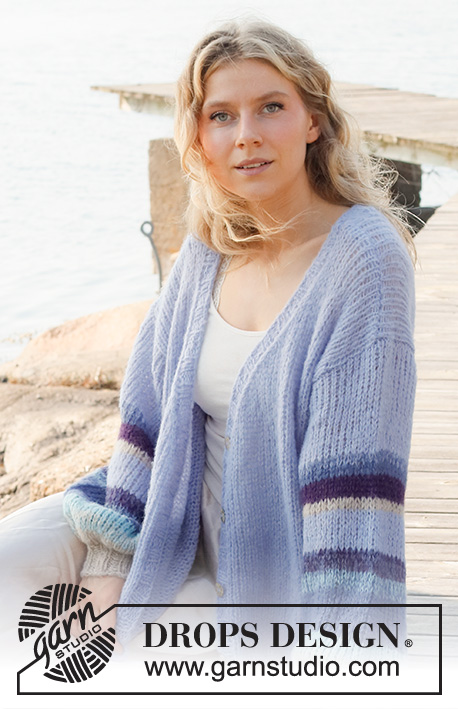 |
|||
Knitted jacket in 2 strands DROPS Brushed Alpaca Silk. Piece is worked with V-neck and balloon sleeves with stripes. Size XS - XXL.
DROPS 221-23 |
||||
|
------------------------------------------------------- EXPLANATION FOR THE PATTERN: ------------------------------------------------------- GARTER STITCH (back and forth): Knit all rows. 1 ridge vertically = knit 2 rows. V-NECK: All decreases are done from the right side! Right front piece: Work 1 edge stitch in garter stitch, slip 1 stitch knitwise, knit 1, pass slipped stitch over. Left front piece: Work until 3 stitches remain on row, knit 2 together, work 1 edge stitch in garter stitch. STRIPES: 2 rounds 2 strands light beige. 4 rounds 1 strand light beige + 1 strand light sea green. 4 rounds 2 strands light sea green. 10 rounds 2 strands denim blue. 4 rounds 1 strand denim blue + 1 strand light sea green. 4 rounds 1 strand denim blue + 1 strand purple 8 rounds 2 strands light lavender. 2 rounds 2 strands light beige. 4 rounds 2 strands purple. 2 rounds 2 strands denim blue. 2 rounds 1 strand denim blue + 1 strand light lavender. Then work with 2 strands light lavender until finished measurements. DECREASE TIP-1 (evenly): All decreases are done from the right side! To calculate how to decrease evenly, use the total number of stitches on row (e.g. 116 stitches), minus edge stitches (2 stitches) and divide by number of decreases to be done (e.g. 13) = 8.8. In this example decrease by knitting approx. every 8th and 9th stitch together, and do not decrease of edge stitches. DECREASE TIP-2 (applies to mid under sleeves): Decrease 1 stitch on each side of marker thread as follows: Work until 3 stitches remain before marker thread and knit 2 together, knit 2 (marker thread is between these 2 stitches), slip 1 stitch knitwise, knit 1, pass slipped stitch over stitch worked. ------------------------------------------------------- START THE PIECE HERE: ------------------------------------------------------- JACKET - SHORT OVERVIEW OF THE PIECE: Work body back and forth on circular needle up to armholes. Then bind off stitches for armholes , and work front pieces and back piece back and forth separately. Work sleeves in the round on double pointed needles/a short circular needle, top down. Then assemble piece and work bands back and forth from mid back of neck. BODY: Cast on 116-124-136-144-156-172 stitches (including 1 edge stitch garter stitch in each side towards mid front) on circular needle size 5 MM = US 8 with 2 strands light lavender. Work rib as follows: 1 edge stitch in GARTER STITCH - read explanation above - * knit 2, purl 2 *, repeat from *-* until 3 stitches remain on row, knit 2, 1 edge stitch in garter stitch. Continue rib back and forth like this for 3 cm = 1⅛". Knit 1 row from right side while decreasing 13-13-17-17-17-17 stitches evenly - read DECREASE TIP-1 = 103-111-119-127-139-154 stitches. Switch to circular needle size 8 MM = US 11. Now insert a marker thread 26-28-30-32-35-39 stitches in from each side (= 51-55-59-63-69-76 stitches on back piece). Move the marker threads upwards when working. Use them later when decreasing stitches for armholes. Continue back and forth in stockinette stitch with 1 edge stitch in garter stitch in each side towards mid front. REMEMBER THE KNITTING GAUGE! When piece measures 29-31-33-34-36-36 cm = 11⅜"-12¼"-13"-13⅜"-14¼"-14¼", begin decrease for V-NECK – read explanation above. Decrease like this on every 6th-6th-6th-6th-6th-0 row 1-1-1-1-1-0 times, then on every 4th row 7-7-7-7-8-10 times (= 8-8-8-8-9-10 times in total). AT THE SAME TIME when piece measures 34-36-37-38-39-40 cm = 13⅜"-14¼"-14½"-15"-15¼"-15¾", work next row from wrong side as follows: Work until 1-1-1-2-3-5 stitches remain before the first marker thread (= front piece), bind off the next 2-2-2-4-6-10 stitches for armhole (= 1-1-1-2-3-5 stitches on each side of marker thread), work the next 49-53-57-59-63-66 stitches (= back piece), bind off the next 2-2-2-4-6-10 stitches for armhole (= 1-1-1-2-3-5 stitches on each side of marker thread), work the rest of row. Finish front pieces and back piece separately. RIGHT FRONT PIECE: Continue back and forth in stockinette stitch, 1 edge stitch in garter stitch in each side and decreases for V-neck. When all decreases for V-neck are done, 17-19-21-22-23-24 stitches remain for shoulder. When piece measures 20-20-21-22-23-24 cm = 8"-8"-8¼"-8¾"-9"-9½" from stitches bind off for armholes, bind off all stitches by knitting from right side - make sure that the bind-off edge is not too tight. Piece measures approx. 54-56-58-60-62-64 cm = 21¼"-22"-22¾"-23⅝"-24⅜"-25¼" from shoulder and down. LEFT FRONT PIECE: Continue back and forth in stockinette stitch, 1 edge stitch in garter stitch in each side and decreases for V-neck. When all decreases for V-neck are done, 17-19-21-22-23-24 stitches remain for shoulder. When piece measures 20-20-21-22-23-24 cm = 8"-8"-8¼"-8¾"-9"-9½" from stitches bind off for armholes, bind off all stitches by knitting from right side - make sure that the bind-off edge is not too tight. Piece measures approx. 54-56-58-60-62-64 cm = 21¼"-22"-22¾"-23⅝"-24⅜"-25¼" from shoulder and down. BACK PIECE: = 49-53-57-59-63-66. Work in stockinette stitch back and forth with 1 edge stitch in GARTER STITCH – read explanation above, in each side. When piece measures 18-18-19-20-21-22 cm = 7"-7"-7½"-8"-8¼"-8¾" from division, bind off the middle 13-13-13-13-15-16 stitches for neck and finish each shoulder separately. Then on next row from the neck, bind off 1 stitch = 17-19-21-22-23-24 stitches. When piece measures 20-20-21-22-23-24 cm = 8"-8"-8¼"-8¾"-9"-9½" from division, bind off all stitches by knitting from right side - make sure that the bind-off edge is not too tight. Piece measures approx. 54-56-58-60-62-64 cm = 21¼"-22"-22¾"-23⅝"-24⅜"-25¼" from shoulder and down. Work the other shoulder the same way. SLEEVES: Cast on 28-28-28-32-32-32 stitches on double pointed needle size 5 MM = US 8 with 2 strands light beige. Work rib (knit 2/purl 2) in the round for 5 cm = 2". Switch to circular needle size 8 mm = US 11. Work next round as follows: * knit 1, make 1 yarn over *, work from *-* on round = 56-56-56-64-64-64 stitches. Knit 1 round (knit yarn overs twisted to avoid holes). Continue in the round with stockinette stitches and STRIPES - read explanation above. When sleeve measures 20 cm = 8" from cast-on edge, insert 1 marker thread at the beginning of round (= mid under sleeve). Now decrease 1 stitch on each side of marker thread - read DECREASE TIP-2. Decrease like this every approx. 4-4-5-3½-4-4½ cm = 1½"-1½"-2"-1¼"-1½"-1⅝" 6-6-5-8-6-5 times in total = 44-44-46-48-52-54 stitches. When sleeve measures 52-52-51-50-48-47 cm = 20½"-20½"-20"-19¾"-19"-18½" (shorter measurements in larger sizes because of wider shoulders and longer sleeve caps), work sleeve cap back and forth on circular needle until finished measurements. Work until sleeve measures approx. 54-54-53-53-52-52 cm = 21¼"-21¼"-21"-21"-20½"-20½", i.e. there is a vent of 2-2-2-3-4-5 cm = ¾"-¾"-¾"-1⅛"-1½"-2" at the top of sleeve. ASSEMBLY: Assemble with 2 strands light lavender. Sew the shoulder seams together. Sew sleeve cap to armhole. Then sew vent at the top of sleeve to the bottom of armhole – see chart. RIGHT BAND: Use circular needle size 5 MM = US 8 and 2 strands light lavender. Begin from right side at the bottom of right front piece and pick up 72 to 88 stitches inside 1 edge stitch from bottom edge until mid back of neck (number of stitches should be divisible by 4). Work first row from wrong side as follows: Work 1 edge stitch in garter stitch, purl until 1 stitch remains, at the same time increase by making a yarn over right were decrease for V-neck began, as follows: * Purl 1, 1 yarn over *, work from *-* 4 times (= 4 stitches increased), finish with 1 edge stitch in garter stitch. Now work rib as follows: 1 edge stitch in garter stitch, * knit 2, purl 2 *, work from *-* until 3 stitches remain, knit 2, 1 edge stitch in garter stitch. Continue back and forth like this. When rib measures 1 cm = ⅜", decrease for 4-4-4-5-5-5 buttonholes evenly. Place top buttonhole approx. 1 cm = ⅜" below decrease for V-neck began, and bottom buttonhole approx. 4 cm = 1½" from bottom edge. 1 buttonhole = make 1 yarn over and knit 2 together. NOTE: It will look best if decrease is done in a purl section (seen from right side). When rib measures 3 cm = 1⅛", bind off with knit over knit and purl over purl. LEFT BAND: Use circular needle size 5 MM = US 8 and 2 strands light lavender. Begin from right side mid back of neck, and pick up approx. 72-88 stitches inside 1 edge stitch along neck line in the back of neck and then down along front piece (number of stitches should be divisible by 4). Work first row from wrong side as follows: Work 1 edge stitch in garter stitch, purl until 1 stitch remains, at the same time increase by making a yarn over right were decrease for V-neck began, as follows: * Purl 1, 1 yarn over *, work from *-* 4 times (= 4 stitches increased), finish with 1 edge stitch in garter stitch. Now work rib as follows: 1 edge stitch in garter stitch, * knit 2, purl 2 *, work from *-* until 3 stitches remain, knit 2, 1 edge stitch in garter stitch. Continue back and forth like this. When rib measures 3 cm = 1⅛", bind off with knit over knit and purl over purl - remember BIND-OFF TIP. Sew the 2 bands together mid back of neck inside 1 edge stitch in garter stitch. Sew the buttons on to left band. |
||||
Diagram explanations |
||||
|
||||

|
||||

|
||||
|
Have you made this or any other of our designs? Tag your pictures in social media with #dropsdesign so we can see them! Do you need help with this pattern?You'll find tutorial videos, a Comments/Questions area and more by visiting the pattern on garnstudio.com. © 1982-2024 DROPS Design A/S. We reserve all rights. This document, including all its sub-sections, has copyrights. Read more about what you can do with our patterns at the bottom of each pattern on our site. |
||||







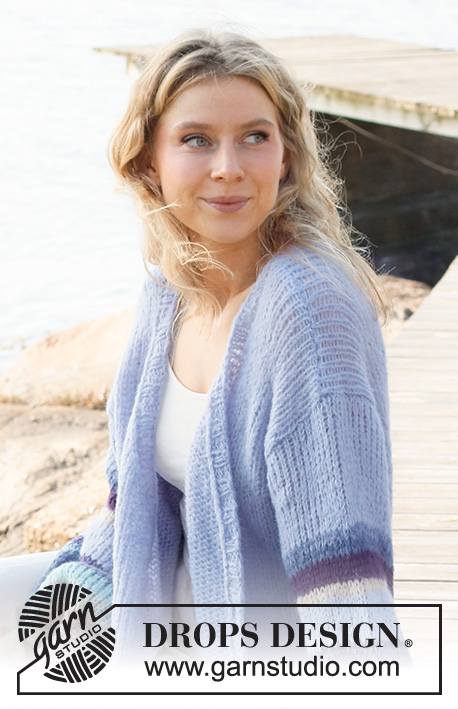
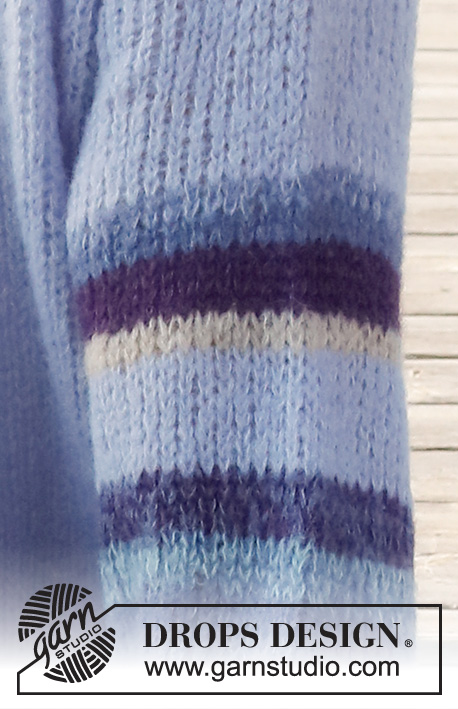


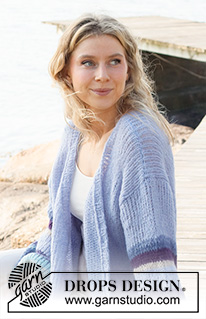
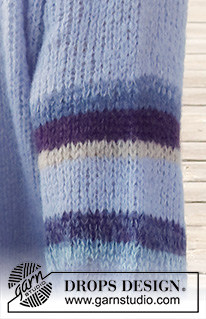


























































Comments / Questions (19)
Hallihallo, Meine Jacke ist fast fertig gestellt und ich bin gerade dabei die Ärmel zu stricken . Meine Frage: gibt es eine Beschreibung, wie ich die Armkugel stricken muss? Ich finde leider nichts dazu und weiß nicht wirklich weiter. Vielen Dank! Liebe Grüße Janna
02.06.2023 - 13:13DROPS Design answered:
Liebe Janna, in diesem Video zeigen wir, wie so eine Ärmel fertig gestrickt wird, und ab ca 02:50 wie man die Ärmal annähen wird - (vielleicht kann Ihnen dann auch dieses Video mit helfen. Viel Spaß beim stricken!
02.06.2023 - 14:57Bonjour, quelle quantité de laine il faudrait pour tout tricoter d'une seule couleur ? Merci!
20.11.2022 - 14:33DROPS Design answered:
Bonjour Charlotte, nous n'avons malheureusement que la quantité de ce modèle avec les rayures, et n'avons plus le gilet pour le peser; ajoutez les différentes couleurs, il vous en faudra probablement un peu moins; votre magasin DROPS saura vous aider et vous conseiller - même par mail ou téléphone. Bon tricot!
21.11.2022 - 09:24In de beschrijving staat elke 6de naald 1 x mindere en elke 4e naald 8 x. Is het nu dat je maar 1 x de 6de minderd en 8 x de 4de minder of snap ik het verkeerd
14.01.2022 - 16:44DROPS Design answered:
Dag Debby,
Je mindert 1 keer op de 6e naald, daarna minder je nog eens 8 keer, maar niet dan telkens op de 4e naald, dus na die eerste mindering tel je steeds 4 naalden en dan maak je weer een mindering.
16.01.2022 - 14:40Ich verstehe nicht ganz wie man die Vorderteile weiter strickt sobald man mit dem rumpfteil fertig ist. Werden nochmal neue Maschen aufgenommen oder wie stricke ich dann weiter? Mir ist der Vorgang dieser Anleitung nicht ganz ersichtlich was dieses rumpfteil sein soll.
14.11.2021 - 12:29DROPS Design answered:
Liebe Angelina, die Jacke wird von unten nach oben zuerst in einem Teil (re. Vorderteil + Rückenteil + li. Vorderteil) gestrickt, dann werden Maschen für die beiden Armlöcher abgekettet und jedes Teil wird separat bis zur Ende gestrickt. Beim beiden Vorderteil werden Sie Maschen für Halsausshnitt abnehmen und dann für Schulter abketten. Beim Rückenteil stricken Sie gerade bis Halsausschnitt und enden Sie jedes Schulter separat. Kann das Ihnen helfen?
15.11.2021 - 08:08Rigtig smart.
09.11.2021 - 06:15Was ist mit dem Rumpfteil gemeint? Ich verstehe nicht wo dies am Schluss an der Jacke angebracht wird
20.10.2021 - 21:45DROPS Design answered:
Liebe Frau Wlach, die Jacke wird von unten nach oben gestrickt, am Anfang stricken Sie re. Vorderdteil + Rückenteil + li. Vorderteil (= Rumpfteil) in einem Stück bis zum Armlöchern dann wird jedes Teil einzeln gestrickt. Kann das Ihnen helfen?
21.10.2021 - 07:11I ærmet str L står der at der skal være 48 masker efter indtagning. Man starter med 64 masker, skal tage ind 4 x 2 masker. Det giver 56?
01.09.2021 - 06:20DROPS Design answered:
Hei Kristen. Ja, her er det noe feil. Oppskriften er videresendt til design avd slik at de kan kontrollere om det skal flere fellinger til eller maskeantallet skal forandres. mvh DROPS design
06.09.2021 - 13:33Guten Tag, mit welcher Nadelstärke soll man die Maschenprobe stricken? Und wodurch erkennt man die linke-, rechte Seite und Rückenteil, die man seperat stricken soll? An den abgeketteten Armausschnitten vielleicht? Danke im Voraus!
19.08.2021 - 11:57DROPS Design answered:
Liebe Frau Peters, die Maschenprobe soll mit Nadeln Nr 8 glatt rechts gestrickt werden. Nach den Bündchen nehmen Sie regelmäßig verteilt ab und dann setzen Sie Markierungen (= 26-28-30-32-35-39 M für jedes Vorderteil und 51-55-59-63-69-76 M für das Rückenteil). Viel Spaß beim stricken!
19.08.2021 - 14:37So ein komplizierte Anleitung hab noch nie erlebt..
16.08.2021 - 21:47DROPS Design answered:
Liebe Loreta, gerne können Sie Ihre Frage hier stellen, so können wir Ihnen weiterhelfen, gerne wird Ihnen auch Ihr DROPS Laden weiterhelfen - auch telefonisch oder per E-Mail. Viel Spaß beim stricken!
17.08.2021 - 10:29Hallo, ich verstehe beim Rumpfteil nicht wie man in jeder 6. Reihe und 4. Reihe abnimmt. Insgesamt 8 also eigentlich 6. Reihe doch nur 1 mal und 4. Reihe 7 mal oder? Und wie strickt man rechtes und linkes Vorderteil separat?
16.08.2021 - 08:09DROPS Design answered:
Liebe Frau Duhm, die 1. Abnahme für V-Ausschnitt wird bei 29-36 cm gestrickt, dann stricken Sie 5 Reihen, und *bei der nächsten Hinreihe nehmen Sie noch mal für den V-Auschnitt, stricken Sie dann 3 Reihen* und von *-* insgesamt 7 Mal stricken = es sind jeweils 8 Maschen für den V-Ausschnitt abgenomen. Gleichzeitig, nach 34-40 cm stricken Sie jedes Teil separat fertig, dh die Maschen von linken Vorderteil und Rückenteil stilllegen und das rechte Vorderteil bis Schulter stricken, Faden abschneiden, linkes Vorderteil bis Schulter stricken und dann Rückenteil bis Schulter stricken. Viel Spaß beim stricken!
16.08.2021 - 08:35